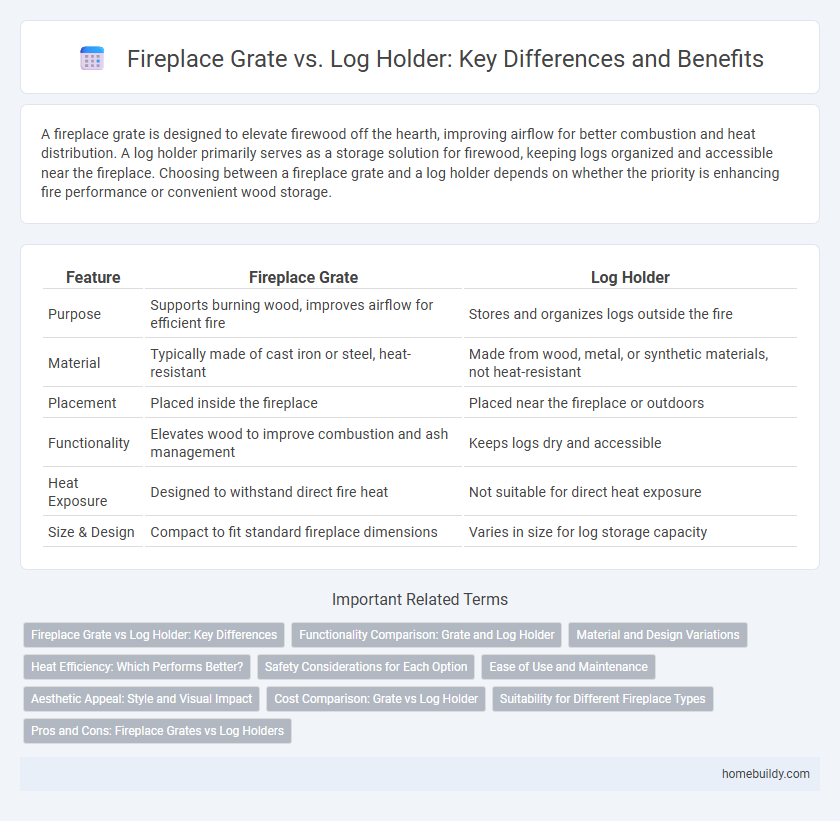A fireplace grate is designed to elevate firewood off the hearth, improving airflow for better combustion and heat distribution. A log holder primarily serves as a storage solution for firewood, keeping logs organized and accessible near the fireplace. Choosing between a fireplace grate and a log holder depends on whether the priority is enhancing fire performance or convenient wood storage.
Table of Comparison
| Feature | Fireplace Grate | Log Holder |
|---|---|---|
| Purpose | Supports burning wood, improves airflow for efficient fire | Stores and organizes logs outside the fire |
| Material | Typically made of cast iron or steel, heat-resistant | Made from wood, metal, or synthetic materials, not heat-resistant |
| Placement | Placed inside the fireplace | Placed near the fireplace or outdoors |
| Functionality | Elevates wood to improve combustion and ash management | Keeps logs dry and accessible |
| Heat Exposure | Designed to withstand direct fire heat | Not suitable for direct heat exposure |
| Size & Design | Compact to fit standard fireplace dimensions | Varies in size for log storage capacity |
Fireplace Grate vs Log Holder: Key Differences
Fireplace grates are designed to hold logs securely above the fireplace floor, enhancing airflow for a more efficient burn and easier ash collection, whereas log holders primarily serve as storage racks for firewood outside or near the fireplace. Grates are constructed from heat-resistant materials like cast iron or steel to withstand high temperatures, while log holders often use lighter metals or wood and are not intended for direct fire contact. The key difference lies in functionality: grates improve combustion and safety during burning, whereas log holders facilitate wood organization and accessibility.
Functionality Comparison: Grate and Log Holder
A fireplace grate elevates logs to improve air circulation, promoting efficient combustion and reducing smoke inside the room. In contrast, a log holder serves primarily as a storage solution for firewood, keeping logs organized and readily accessible but not designed for burning. Choosing between a grate and a log holder depends on whether the priority is optimizing fire performance or convenient wood storage.
Material and Design Variations
Fireplace grates are typically constructed from heavy-duty cast iron or steel, designed to withstand intense heat and support larger logs, optimizing airflow for efficient combustion. Log holders often use lighter materials like wrought iron or stainless steel and feature open, decorative designs suitable for indoor storage or smaller fires. Material durability and structural design variations directly impact heat resistance, wood placement, and overall fireplace performance.
Heat Efficiency: Which Performs Better?
Fireplace grates improve heat efficiency by elevating logs, allowing better air circulation and more complete combustion, which generates consistent and intense heat. Log holders mainly serve as storage tools and lack the design features to enhance airflow, resulting in less efficient burning and heat output. Optimal heat performance is achieved with grates due to their structure promoting efficient fuel use and maximizing warmth in the room.
Safety Considerations for Each Option
Fireplace grates provide a stable and raised platform for logs, promoting better airflow and more efficient burning while reducing the risk of logs rolling out, which enhances safety compared to log holders. Log holders, often designed for storage outside the fireplace, can risk instability and accidental tipping if used inside, increasing fire hazards. Choosing a heavy-duty, properly sized fireplace grate ensures secure log containment and minimizes sparks or embers escaping, making it the safer option within active fireplaces.
Ease of Use and Maintenance
Fireplace grates offer superior ease of use by securely elevating logs for optimal airflow, resulting in more efficient burning and less frequent repositioning compared to log holders. Maintenance is simplified with grates due to their sturdy metal construction that resists warping and collects ashes underneath, facilitating easier cleaning. Log holders, while aesthetically pleasing, often require manual adjustments and more frequent ash removal, making fireplace grates a practical choice for hassle-free operation and upkeep.
Aesthetic Appeal: Style and Visual Impact
Fireplace grates typically offer a robust, industrial look that enhances the traditional ambiance of a hearth, while log holders emphasize sleek design and decorative appeal for modern interiors. The visual impact of a fireplace grate centers on functionality and heat distribution, often featuring cast iron or steel with intricate patterns. In contrast, log holders prioritize style with materials like wrought iron or wood, serving as both storage and a decorative element that complements the room's decor.
Cost Comparison: Grate vs Log Holder
Fireplace grates typically cost between $40 and $150, offering durable support for larger firewood and enhancing airflow for efficient burning. Log holders are generally more affordable, ranging from $20 to $80, and provide a simple solution for storing firewood outside the fireplace. Choosing between a grate and a log holder depends on budget and functional needs, with grates offering better fire management and log holders serving primarily as storage.
Suitability for Different Fireplace Types
Fireplace grates are designed to improve airflow and combustion in traditional wood-burning fireplaces, making them ideal for masonry and built-in fireplaces that accommodate larger logs. Log holders, often simpler and more decorative, suit freestanding or gas fireplaces where airflow optimization is less critical. Choosing between a fireplace grate and a log holder depends on the fireplace type, with grates preferred for maximizing heat and efficiency in brick or stone fireplaces, while log holders better complement modern or smaller hearths.
Pros and Cons: Fireplace Grates vs Log Holders
Fireplace grates improve airflow for efficient burning by elevating logs, reducing smoke and allowing ashes to fall below, but they can be bulkier and harder to clean than log holders. Log holders offer easier loading and a more compact design, enhancing convenience and storage, yet they may restrict air circulation, potentially leading to slower combustion and increased smoke. Choosing between a fireplace grate and a log holder depends on priorities such as combustion efficiency versus ease of use and space savings.
Fireplace grate vs Log holder Infographic

 homebuildy.com
homebuildy.com